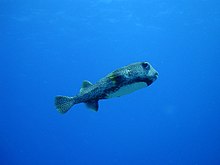
Diodon

| Porcupinefishes | |
|---|---|

| |
| Diodon holocanthus | |
| Scientific classification | |
| Domain: | Eukaryota |
| Kingdom: | Animalia |
| Phylum: | Chordata |
| Class: | Actinopterygii |
| Order: | Tetraodontiformes |
| Family: | Diodontidae |
| Genus: | Diodon Linnaeus, 1758 |
| Type species | |
| Diodon hystrix Linnaeus, 1758
| |
Porcupinefishes or balloonfishes, are any of the various species of the genus Diodon, the type genus of Diodontidae.

Distinguishing features
Fish of the genus Diodon have:

- two-rooted, movable spines (which are derived from modified scales) distributed over their bodies.
- beak-like jaws, used to crush their hard-shelled prey (crustaceans and molluscs).[2]
They differ from the swelltoads and burrfishes (genera Cyclichthys and Chilomycterus, respectively), which, in contrast, have fixed, rigid spines.

Defense mechanisms
- Like true pufferfishes of the related family Tetraodontidae, porcupinefishes can inflate themselves. Once inflated, a porcupinefish's erected spines stand perpendicular to the skin, whereupon they then pose a major difficulty to their predators: a large porcupinefish that is fully inflated can choke a shark to death. According to Charles Darwin in The Voyage Of the Beagle (1845), Darwin was told by a Doctor Allen of Forres, UK that the Diodon actually had been found "floating alive and distended, in the stomach of the shark" and had been known to chew its way out of shark bodies after being swallowed, causing the death of its attacker.[3]
- They may be poisonous, through the accumulation of tetrodotoxin or ciguatera.[2]
Species

Extant
There are currently five recognized extant species in this genus:[4]

| Image | Scientific name | Common Name | Distribution |
|---|---|---|---|
 |
Diodon eydouxii Brisout de Barneville, 1846 | Pelagic porcupinefish | circumtropical distribution |
 |
Diodon holocanthus Linnaeus, 1758 | Long-spined porcupinefish | tropical zones of major seas and oceans |
 |
Diodon hystrix Linnaeus, 1758 () | Spot-fin porcupinefish | tropical and subtropical waters of the world, including the Mediterranean Sea |
 |
Diodon liturosus G. Shaw, 1804 | Black-blotched porcupinefish | tropical and subtropical waters of the Indo-Pacific area from eastern coasts of Africa to Japan |
 |
Diodon nicthemerus G. Cuvier, 1818 | Slender-spined porcupinefish | southern Australia, as far north as Port Jackson to Geraldton, Western Australia |
Fossil
Fossils of porcupinefishes are known from Tertiary-aged marine strata. These species are similar to modern species. Fossil species include:

- Diodon tenuispinus, from the Ypresian-aged Monte Bolca lagerstatte.
- Diodon scyllai, from middle Miocene-aged Piemonte, Italy.
References
- ^ Sepkoski, J. (2002). "A compendium of fossil marine animal genera". Bulletins of American Paleontology. 364: 560. Archived from the original on 2011-07-23.
- ^ a b Lieske, E. & Myers, R.F. (2004): Coral reef guide; Red Sea London, HarperCollins ISBN 0-00-715986-2
- ^ Darwin, C. (1845). Journal of researches into the natural history and geology of the countries visited during the voyage of H.M.S. Beagle round the world, under the Command of Capt. Fitz Roy, R.N. 2d edition. London: John Murray. p. 14.
- ^ Matsuura, K (2014). "Taxonomy and systematics of tetraodontiform fishes: a review focusing primarily on progress in the period from 1980 to 2014". Ichthyological Research. 62 (1): 72–113. Bibcode:2015IchtR..62...72M. doi:10.1007/s10228-014-0444-5.

See what we do next...
OR
By submitting your email or phone number, you're giving mschf permission to send you email and/or recurring marketing texts. Data rates may apply. Text stop to cancel, help for help.
Success: You're subscribed now !
